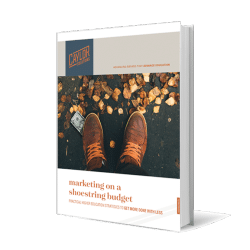Digital Natives and AI: What Higher Ed Can Learn from Gen Z
How can higher ed engage digital natives and cultivate AI fluency at the same time? Conor and Finn Grennan share insights for the next generation of learners.
Enrollment
What I’ve been reading lately doesn’t bode well for private colleges and universities.
The National Student Clearinghouse Research Center is a nonprofit that monitors the academic behaviors of “students who attend degree-granting institutions that are eligible to receive federal financial aid.”
In one recent report, postsecondary enrollment numbers across the nation have decreased by more than 231,000 students.
For the first time in over ten years, unduplicated enrollments have fallen below 18 million students, sinking by more than two million students.
Some demographic pundits project “to have 450,000 fewer students in the years beyond 2025” which will “mean 25,000 fewer faculty positions.”
In another study, the National Student Clearinghouse Research Center showed that adult student enrollment numbers have also sharply lowered, with 1.3 million fewer students studying in 2016.
This trend has continued well into more recent enrollment cycles.
The National Student Clearinghouse Research Center 2019 report reveals “the average age of full-time undergraduate students dropped from 22.3 to 21.8 years old.”
On a side note, a look at the genders in these numbers isn’t very surprising.
As has been the case for decades, postsecondary enrollment skews towards higher numbers of female students — but both genders are experiencing quite a hit.
In fall 2018, 159,000 fewer male students and 84,000 fewer female students enrolled in higher education institutions.
Why are we seeing such abysmal numbers? As expected, there are several factors.
Dr. Sally M. Johnstone, president of the National Center for Higher Education Management Systems, said in this Diverse article:
“We are at a point culturally in the United States right now where the value of college is being questioned. So, there are fewer people that would be expected to go to a postsecondary education and are doing that.”
The consequences of this negative shift in American attitudes towards higher education cannot be overstated.
No enrollment marketer can sell a postsecondary education if the market doesn’t want it.
Alana Dunagan of the Clayton Christensen Institute observed in this article from the James G. Martin Center that businesses are now providing training they once dropped during the 2008 recession.
During the recession, many adult students who had lost their jobs came to postsecondary institutions to revamp their skills and marketability in a tougher job market.
Now in our current booming job market, adult student enrollment is declining as people go back to work.
Recently, there’s also been an explosion of self-directed study courses like Udemy, Skillshare, and Teachable.
While these courses don’t offer traditional college degrees, they are providing a path to hirable skills, which is attracting more and more prospective students.
The face of prospective students is changing, getting much more diverse.
Especially in states like Texas, the number of Hispanic households is growing rapidly. But other minorities like African Americans and Asian Americans are growing too.
This demographic change affects enrollment numbers directly as many of these families are immigrants who do not have the means to put their children through college.
The children and/or grandchildren that do go to college rely heavily on first generation financial aid.
Necessary or not, tuition prices have been increasing over the past decade, leading to vocal public debates over the value and cost of higher education.
Unfortunately, this issue keeps getting more and more political, but it still is a reality that keeps many students from considering a postsecondary education.
As student debt soars to over $1.4 trillion, it appears we’re reaching a critical price point where prospective students decide to not even try.
Typically, private institutions are the hardest hit when states cut education spending, but there’s plenty of evidence that everyone’s tightening the belt.
For example, in June 2019, Alaskan lawmakers passed legislation that is going to cut spending to the University of Alaska by $70 million over the next three years.
Getting to the real issue, Dr. Johnston pointed out that these budget cuts in Alaska had a lot to do with “some loss of faith… in the university structure.”
In addition, many private institutions are feeling even more of the pressure as up to 20 states are providing a certain level of free education.
All these factors create the perfect storm which is devastating higher education budgets across the country.
On and on the cycle goes.
When it rains, it pours.
 Thankfully, there’s a lot you can do to get through these “rainy days.”
Thankfully, there’s a lot you can do to get through these “rainy days.”
If you haven’t committed yourself to a content marketing strategy, now is the time!
As I point out in this article, with a solid content marketing strategy, you can…
One of the things I like the most about content marketing is that you can do it with little to no money – and still get incredible results.
In my Marketing on a Shoestring Budget ebook (get it for FREE here), I share a list of content creation tools like high quality video production, audio production, and digital marketing tools that can generate powerful marketing results with just a $2,000 investment – or less!
Don’t let the numbers get you down. Students still want to go to school!
But if your website is a complicated smorgasbord of options, you’ll lose future students in the mess.
Trim the massive lists of departments, programs, initiatives, and policies from your website menus and clear the way for prospective students and their families to quickly get to the questions they’re really asking.
Do this and you’ll be miles ahead of other institutions that prefer to cater to the demands of their department chairs instead of the needs of prospective students.
With all due respect to our venerated faculty members, which of these will eventually pay the light bill? The department chairs or the prospective student?
I rest my case.
Focus your website on the needs, tastes, and desires of prospective students.
Okay, so this point is going to feel like the big sales pitch…
And it is.
But the pitch is probably not what you’re thinking.
You see, I believe in this so much that even if you don’t hire Caylor Solutions to improve your enrollment marketing, you still need to do it.
Find a highly reputable education marketing agency who has a proven track record of improving enrollment numbers on a budget.
I know every dollar in your budget is precious – but this is an investment that can save you massive headaches and loads of money.
So if you’re ready to silence the naysayers, contact us for a free consultation.
And if you’re worried about the budget, please download a free copy of the ebook I mentioned above, Marketing on a Shoestring Budget.
Inside, I’ll show you proven marketing tactics like…
No hype. No pie in the sky. Just real solutions for getting the job done with the budget you’ve got.
Featured image by Yakobchuk Olena via Adobe Stock
Rainbow umbrella image by Stockphoto-Graf via Adobe Stock
Subscribe to The Higher Ed Marketer podcast today!